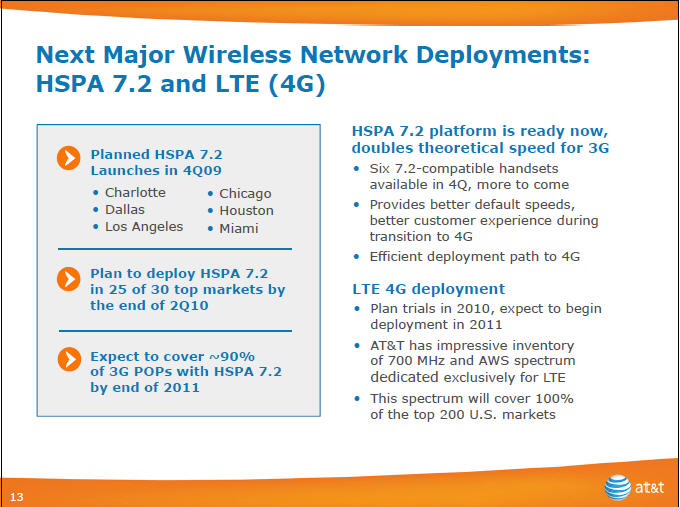AT&T hurries along 3G network upgrade, but NY, SF still hurting; Here's why

Time to play a little compare and contrast. AT&T said Wednesday that it has completed a software upgrade at its 3G cell sites so it can deploy faster technology. However, the New York and San Francisco upgrades are still a work in progress due to everything from outdated technology to zoning issues.
In a nutshell, AT&T is letting folks know that it has made an incremental step in its deployment of High-Speed Packet Access (HSPA) 7.2 technology.
In a statement, AT&T said:
After full testing of HSPA 7.2 software, AT&T decided to expedite deployment of this initial upgrade, which will result in a better overall customer experience by generally improving consistency in accessing data sessions. The software upgrade also prepares the network for faster speeds and increases network efficiency.
Faster 3G speeds will come as AT&T combines the new technology with enhanced cell site backhaul connections over the course of 2010 and 2011. AT&T is in the midst of this second initiative to dramatically increase the number of high-speed backhaul connections to cell sites, primarily with fiber-optic connections, adding capacity from cell sites to the AT&T backbone network.
That passage is good news for areas already getting the backhaul upgrades. AT&T said it is bolstering its network in initial HSPA 7.2 markets such as Charlotte, Chicago, Dallas, Houston, Los Angeles, and Miami already.
The AT&T statement coincided with John Stankey's talk at the Citigroup entertainment, media and telecom conference on Tuesday. I listened to Stankey's talk and had a different take from AT&T's statement. My interpretation of Stankey's talk went like this:
- AT&T is upgrading its 3G network (like the statement said);
- AT&T's network is still hurting in its two highest profile locations---New York and San Francisco;
- Network improvements vary dramatically by location and moving parts abound for AT&T.
None of those items is news. AT&T has talked about its network upgrade for months. Stankey's talk got to the network quality point quickly and did offer a bit more color. The good news was that AT&T's quality metrics are improving. However, there are exceptions. Let's roll the transcript (my emphasis added):
There are a couple of exceptions, and the most notable of those are one of the markets you are in today here in San Francisco, and New York City. Now I wish I could tell you that there is just one issue to deal with in those markets to correct them.
Unfortunately, with any complex problem it's not normally one issue. There is usually a variety of things that have to be dealt with. The characteristics in each of the markets and the challenges we are working through are a little bit different in each one.
What I will tell you is we feel like that we know what we need to do and we're making the progress we need to make, albeit -- I thought by the time we'd closed 2009 we would be in a better place in New York City than we were. Reason being New York City is a little bit of a different animal and it's a good example of having to scale in this data environment, where not only do we have a lot of capacity issues to deal with but physically there is network equipment and network elements that are needed to be changed out.
They just flat-out have hit their capacity levels and we have to replace them with new ones. And as a result of that, those transitions and that work has taken us a little bit longer and it's been a little dicier than what we had hoped it would be. We feel like we are on a path over the first quarter of this year to get through the majority of that.
We also believe putting that new equipment in place will ungate us from putting an additional carrier and service, that we move to the third carrier in a lot of the metropolitan areas, or metropolitan areas of Manhattan. And that third carrier will give us the kind of radio spectrum we need on the street to deal with the amount of data and capacity that's being generated there.
San Francisco, coming out of the hole a lot quicker than we are in New York. We feel pretty good about that. Our challenges here that remain are largely zoning-oriented. A little bit tougher in places in San Francisco to do adjustments to antennas that we need to do in areas like the Financial District, where we had antenna structures that worked really well in a 2G environment.
They need to be replaced to support 3G services and it's just taking time to get the zoning ordinances square to replace those antennas and clean up small part -- portions of the city that we are dealing with. Getting those ordinances squared away and the permits squared away to unblock on additional capacity for carriers is another area.
That's a long excerpt, but it's best to take in all of what Stankey had to say. Simply put, upgrading San Francisco and New York is a complicated endeavor. So cheer AT&T's 3G network upgrade, but don't expect a lot of applause from the wireless hotbeds.

Also:
AT&T's wireless chief hints at curbing iPhone data hogs